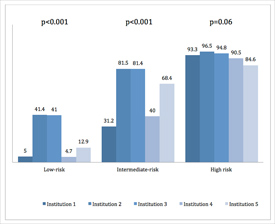BERKELEY, CA (UroToday.com) - Pelvic lymph node dissection (PLND) represents the most accurate staging procedure for patients diagnosed with organ-confined prostate cancer (PCa) who undergo radical prostatectomy. Several reports have shown that patients who undergo robot-assisted radical prostatectomy (RARP) have a lower chance of undergoing PLND, irrespective of the disease characteristics. On the other hand it has been suggested that RARP may also represent an effective treatment for high-risk patients and that an extended PLND is feasible during RARP. Based on these observations, we evaluated the rate and extension of PLND in patients who underwent robot-assisted radical prostatectomy (RARP), and we tested the adherence of the indication for PLND to the European Association of Urology (EAU) guidelines. For this purpose we relied on a multi-institutional cohort of 2 985 consecutive patients who underwent RARP at 5 high-volume European institutions. Patients were stratified according to preoperative cancer risk group.
The rate and extent of PLND across different institutions were analyzed. Univariable and multivariable logistic regression models evaluated the association between preoperative variables and the probability of receiving PLND, as well as the presence of lymph node invasion (LNI). Finally, the probability of LNI was calculated for each patient, and the indication for PLND was compared with the EAU guidelines’ indications.
A lymph node dissection was performed in 1 777 patients (59.7%; 34.5% of low-risk patients, 64.9% of intermediate-risk patients, and 91.2% of high-risk patients). Figure 1 shows the different rates across institutions: 5.0–41.4% in low-risk patients (p < 0.001), 31.3–81.4% in intermediate-risk patients (p < 0.001), and 84.6–96.4% in high-risk patients (p=0.06). The mean and median number of nodes removed was 10.8, and 122 patients (4.1%) had nodal metastases. At multivariable analysis, the institution represented an independent predictor of PLND (p < 0.001). Of patients with current indication for PLND according to the EAU guidelines, 77.8% actually received the procedure. Our study represents the first report about the indications for and extension of PLND in a large, multi- institutional European population of patients who underwent RARP. The 3 key results of the study may be summarized as:
- LND during RARP is widely performed in Europe: the rate of PLND ranges between 35 and 68% of patients undergoing RARP,
- the indications for PLND vary significantly according to institutional guidelines, despite the current availability of highly accurate predicting tools for LNI and of the EAU guidelines, and
- the median number of lymph nodes removed (10.85) is quite far from a definition of an extended template. Limitations were the retrospective study design with different pathologic assessment and lack of follow-up data.
In summary, PLND is widely performed in patients undergoing RARP in high-volume centers in Europe for whom the procedure is currently indicated by the EAU guidelines. The rate and extension of PLND vary significantly among institutions, especially in low- and intermediate-risk patients. An effort toward a more rigorous standardization of LND in terms of both indication and extension is advocated.
Figure 1: Percentage of rLND performed among 5 different European centers according to preoperative risk group
Written by:
Nazareno Suardi as part of Beyond the Abstract on UroToday.com. This initiative offers a method of publishing for the professional urology community. Authors are given an opportunity to expand on the circumstances, limitations etc... of their research by referencing the published abstract.
Department of Urology, Urological Research Institute, University Vita-Salute San Raffaele, Milan, Italy

More Information about Beyond the Abstract


